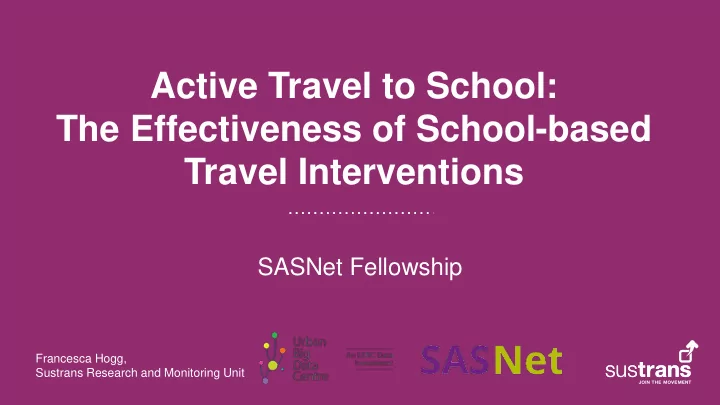

Active Travel to School: The Effectiveness of School-based Travel Interventions SASNet Fellowship Francesca Hogg, Sustrans Research and Monitoring Unit
SASNet Fellowship Programme The fellowship has enabled Sustrans to attend training sessions, receive advice on research Aim: To investigate the approach and method as well as accessing relationship between the UBDC data. delivery of active travel infrastructure and behaviour change This research partnership has sought to make initiatives and their best use of school travel data from the Hands impact on how students Up Scotland Survey (HUSS) Official Statistic, travel to primary school. Sustrans project-level data on primary school- based interventions and spatial data on green space from UBDC.
Sustrans – What does our schools work involve? Our Education and Young People Team works with Local Authorities, schools and other key partners in Scotland to encourage and empower pupils, parents and teachers to make the journey to school as active as possible. Big Pedal – Supporting I Bike UK’s largest schools to programme inter-school develop in 12 LAs cycling and School across scooting Travel Plans Scotland challenge
Key research questions 1. What is the individual effect on active travel to school through the delivery of behaviour change interventions and small scale infrastructure as shown by HUSS data? 2. What is the combined and cumulative effect on active travel to school of the above interventions as shown by HUSS data? 3. Is there a sustained effect on pupil active travel to school from any one or mix of the above behaviour change interventions?
Hands Up Scotland Survey (HUSS) Established in 2008, the Hands Up Scotland Survey looks at how pupils across Scotland travel to school and is the largest national dataset on school travel. Active travel 1,938 schools 49.3% of definition: responded in pupils 2016 travelled c Percentage mode 31 local actively in share occupied by authorities 2016 walking, cycling and scooting/skating to school
Data sources Active travel Interventions: measure: • I Bike HUSS 2013-2016 • School Travel Plan • Big Pedal • Bikeability (Levels 1 and 2) • Cycle parking • Scooter parking
Additional data sources Proximity to a cycle route Urban rural (NCN) classification Proximity to green space Pupil deprivation
Methodology • Tested the findings of the descriptive statistics using a panel model. HUSS and intervention • Active travel showed no correlation with data for 2,063 interventions. Cycling became the focus due primary schools to the nature of the interventions. • Spatial analysis of cycle routes and green space. • Proximity to cycle route and green space added to the model for statistical testing.
Results Active travel to Percentage point Intervention school (%) change from no Intervention Schools with no I Bike 57% 11% intervention: Big Pedal 56% 10% Scooter parking 56% 10% 46% active travel Bikeability 50% 4% mode share Cycle parking 49% 3% School Travel Plan 47% 1% No Intervention 46%
Results One intervention with cycling as the dependant variable Intervention P value Coefficient Significant interventions: I Bike 0.15 0.01 Cycle parking 0.12 0.01 Scooter parking 0.12 0.01 • I Bike School Travel Plan 0.06 0.03 • Cycle parking Bikeability -0.01 0.73 • Scooter parking Big Pedal 0.01 0.90 • School travel plan
Results Two interventions with cycling as the dependant variable Interventions P value Coefficient I Bike and School Travel Plan 0.21 0.01 No correlation between School Travel Plan and Cycle Parking 0.09 0.05 cycling and: Three interventions with cycling as the dependant variable • Pupil deprivation Interventions P value Coefficient • Urban rural I Bike, School Travel Plan and Big 0.19 0.01 Pedal I Bike, School Travel Plan and 0.15 0.04 Bikeability I Bike, School Travel Plan and 0.24 0.05 Scooter parking
Spatial analysis Proximity to cycle routes and green space Intervention P value Coefficient Cycle route within 0.15 0.01 100m Green space 0.12 0.01 within 500m
Limitations • School postcode location not always exact location of school • Green space layer includes golf courses, tennis courts and allotments • Cycle route layer includes main roads, urban roads and on-road cycle routes.
Further research • Cost-effectiveness of interventions • Community links schemes • Inclusion of other intervention data from Living Streets • Excluding green space such as golf courses, allotments, religious grounds. Inclusion of access points. • Only including off-road cycle routes
Key messages to take away Green space I Bike and School and cycle routes Travel Plans are can be effective most effective but there are Three limitations interventions is the maximum
Sustrans is the charity making it easier for people to walk and cycle. We connect people and places, create liveable neighbourhoods, transform the school run and deliver a happier, healthier commute. Join us on our journey. www.sustrans.org.uk Twitter @sustrans www.sustrans.org.uk
Appendix :
Recommend
More recommend